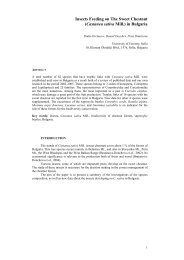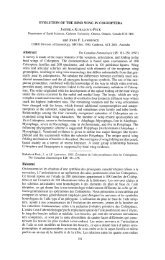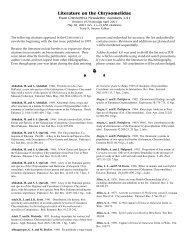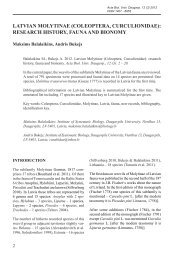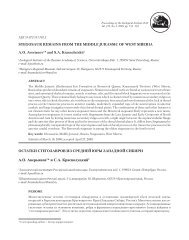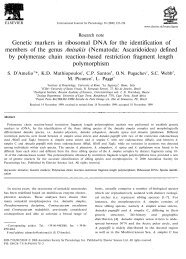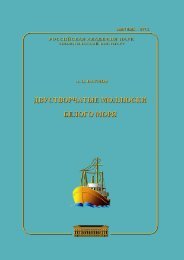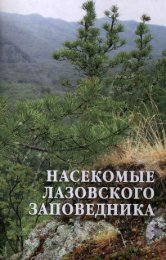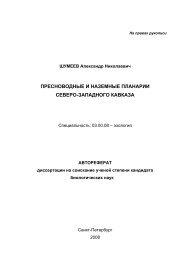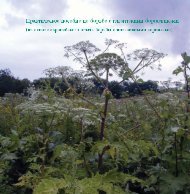Revision of the genus Mniophila STEPHENS, 1831
Revision of the genus Mniophila STEPHENS, 1831
Revision of the genus Mniophila STEPHENS, 1831
Create successful ePaper yourself
Turn your PDF publications into a flip-book with our unique Google optimized e-Paper software.
108 NADEIN, K. S.: <strong>Revision</strong> <strong>of</strong> <strong>the</strong> <strong>genus</strong> <strong>Mniophila</strong> <strong>STEPHENS</strong>, <strong>1831</strong>Alticini. Such features like living in moss, very small size and globose shape <strong>of</strong> a body, reducedhind wings along with o<strong>the</strong>r characters usually rarely present toge<strong>the</strong>r among o<strong>the</strong>r alticines.These are specialized features for a cryptic way <strong>of</strong> life. Similar characters are presented in someo<strong>the</strong>r alticine genera like Mniophilosoma WOLLASTON, 1854, Apteropeda, Minota, ClavicornalticaSCHERER, 1974, Kiskeya KONSTANTINOV et CHAMORRO-LACAYO, 2006, and some o<strong>the</strong>rsgenera. Comparison between <strong>the</strong>se genera reveals that adaptations for a cryptic way <strong>of</strong> life andcorresponding morphological characters apparently originated independently but in similarways and resulted in <strong>the</strong>ir similarity. Significant morphological specialization raises difficultiesin revealing <strong>of</strong> relations <strong>of</strong> <strong>Mniophila</strong> and o<strong>the</strong>r genera with <strong>the</strong> present state <strong>of</strong> knowledge. At<strong>the</strong> same time establishing <strong>of</strong> a separate high-level taxon (tribe or subtribe) for each <strong>genus</strong> willnot clear up <strong>the</strong> situation but will result in fractionation <strong>of</strong> <strong>the</strong> classification. The only <strong>genus</strong>that can be compared with <strong>Mniophila</strong> is Mniophilosoma. The features shared by both genera aresize and globose shape <strong>of</strong> a body and its proportions, shape <strong>of</strong> antennae and labrum, structure<strong>of</strong> thorax, male and female genitalia. <strong>Mniophila</strong> differs from Mniophilosoma in <strong>the</strong> structure <strong>of</strong>a head, particularly shallow and curved ocular sulci, long and narrow frontal ridge, frontal callilarger, pronotal lateral sides rounded, eighth antennomere smaller than seventh and ninth, elytrashorter. The question about <strong>the</strong> relationship <strong>of</strong> <strong>the</strong>se genera cannot be resolved unambiguouslybecause <strong>of</strong> probability <strong>of</strong> convergent similarity.Biological remarks:The <strong>genus</strong> <strong>Mniophila</strong> belongs to “minotoid” morpho-ecological group (NADEIN 2005). The o<strong>the</strong>rgenera belonging to this group are Mniophilosoma, Minota, Apteropeda, Orestia, Clavicornaltica,Kiskeya, some species <strong>of</strong> Psylliodes LATREILLE, 1825. This morpho-ecological group is characterizedby <strong>the</strong> following characters: small or very small size, 1-3 mm; colour dark, usually black, sometimeswith metallic lustre; body compact, rounded, subspherical or elliptic-cylindrical, very convex;head drawn into prothorax, almost invisible from above; antennae and legs short, <strong>of</strong>ten swollen,legs fit into depressions on ventral side <strong>of</strong> body, and antennae into deep grooves lateral to frontalridge. The winglessness is typical for <strong>the</strong> “minotoid” form as well as for many beetles that inhabitmountains.The trophic relations <strong>of</strong> <strong>Mniophila</strong> have been insufficiently studied. The host plants <strong>of</strong> <strong>Mniophila</strong>were recorded for <strong>the</strong> first time by KALTENBACH (1874). This author recorded Digitalis, Plantago(Plantaginaceae) and Teucrium (Lamiaceae) as host plants <strong>of</strong> leaf-mining larva. In that time <strong>the</strong>host plants <strong>of</strong> adults were not recorded and habitation in moss was <strong>the</strong> only indirect record for<strong>the</strong>ir trophic relations. After KALTENBACH (1874) <strong>the</strong>se host plants were mentioned in <strong>the</strong> works<strong>of</strong> KASZAB (1962), MOHR (1966), MEDVEDEV & ROGINSKAYA (1988), GRUEV & TOMOV (1986),JOLIVET & HAWKESWOOD (1995), and DOGUET (1994), etc. Actually such trophic selection raisessome doubts. It is a fact that adults <strong>of</strong> <strong>Mniophila</strong> can only be collected in moss. It means thatbeetles never transfer to o<strong>the</strong>r plants. This could be reliable confirmation that <strong>the</strong>ir host plantsare mosses. This would confirm <strong>the</strong> opinion <strong>of</strong> COX (1997) that <strong>the</strong> larvae are not leaf miner<strong>of</strong> dicots and all stages <strong>of</strong> <strong>the</strong>ir life cycle are spent in moss. The observations on <strong>the</strong> first instarlarva in Great Britain presented by this author revealed that it is most likely an external feederon mosses. According to COX (1997) <strong>the</strong> adults <strong>of</strong> <strong>Mniophila</strong> muscorum have been collected onseveral moss species: Rhytidiadelphus loreus (HEDW.) WARNST., Rhytidiadelphus triquetrus (HEDW.)WARNST. (Hypnaceae), and Eurhynchium striatum (HEDW.) SCHIMP. (Brachy<strong>the</strong>ciaceae). Samples<strong>of</strong> mosses from several localities and biotopes <strong>of</strong> Abkhazia and Crimea were collected duringauthor’s collecting trips in 2007 and 2008. The adults <strong>of</strong> <strong>Mniophila</strong> caucasica sp. n. from Abkhaziahave been collected on following moss genera and species: Ctenidium molluscum (HEDW.) MITT.,Hypnum cupressiforme HEDW. (Hypnaceae); Thamnobryum alopecurum (HEDW.) NIEUWL.,




